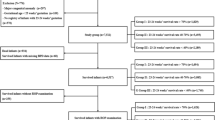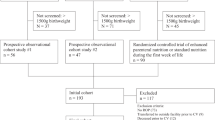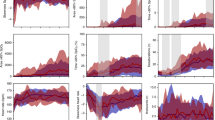Abstract
Retinopathy of prematurity is on the rise and a third epidemic has been identified. In spite of extensive research and progress in the understanding of this disease in recent years, 50 000 children worldwide are blinded by this condition each year. The relation between hyperoxia, low-gestational age, growth retardation, oxygen dependent growth factors, and oxidative stress are now being understood more clearly. We know that in the first phase of retinopathy of prematurity, hyperoxia inhibits vascular endothelial growth factor. In the second phase, vascular endothelial growth factor rises, and when insulin-like growth factor-1 reaches a threshold around 32 to 34 weeks postconceptional age, uncontrolled neovascularization may occur. It is not known whether this new knowledge will have implications for future therapy. However, by strictly avoiding hyperoxia, that is, SaO2>92–93% and avoiding fluctuations in SaO2, it is possible to control and prevent severe retinopathy of prematurity in most cases.
This is a preview of subscription content, access via your institution
Access options
Subscribe to this journal
Receive 12 print issues and online access
$259.00 per year
only $21.58 per issue
Buy this article
- Purchase on Springer Link
- Instant access to full article PDF
Prices may be subject to local taxes which are calculated during checkout

Similar content being viewed by others
References
Engstrom E . Early growth, retinopathy of prematurity and insulin-like growth factors in preterm infants. Medical Thesis, University of Goteborg, 2004.
Campbell K . Intensive oxygen therapy as a possible cause of retrolental fibroplasias: a clinical approach. Med J Aust 1951; 2: 48–50.
Patz A, Hoeck LE, DeLaCruz E . Studies on the effect of high oxygen administration in retrolental fribroplasia. I. Nursery Observations. Am J Ophthalmol 1952; 35: 1248–1253.
Ashton N, Cook C . Direct observation of the effect of oxygen on developing vessels: preliminary report. Br J Ophthalmol 1954; 38: 433–440.
Silverman WA . The lesson of retrolental fibroplasia. Sci Am 1977; 236: 100–107.
Silverman WA . Retinopathy of prematurity: oxygen dogma challenged. Arch Dis Child 1982; 57: 731–733.
Gilbert C, Fielder A, Gordillo L, Quinn G, Semiglia R, Visintin P et al. Characteristics of infants with severe retinopathy of prematurity in countries with low, moderate, and high levels of development: implications for screening programs. Pediatrics 2005; 115: e518–e525.
Schaffer DB, Palmer EA, Plotsky DF, Metz HS, Flynn JT, Tung B et al. Prognostic factors in the natural course of retinopathy of prematurity. Ophthalmol 1993; 100: 230–237.
Darlow BA, Hutchinson JL, Henderson-Smart DJ, Donoghue DA, Simpson JM, Evans NJ . Prenatal risk factors for severe retinopathy of prematurity among very preterm infants of the Australian and New Zealand Neonatal Network. Pediatrics 2005; 115: 990–996.
Villegas BE, Fernandez M, Gonzales R . Valores de IGF-1s cos en ka ROP: buscando nuevas indicaciones para su screening. Arch Soc Esp Oftalmol 2005; 80: 233–238.
Tin W, Milligan DW, Pennefather P, Hey E . Pulse oximetry, severe retinopathy, and outcome at one year in babies of less than 28 weeks gestation. Arch Dis Child Fetal Neonatal Ed 2001; 84: F106–F110.
Chow LC, Wright KW, Sola A . Can changes in clinical practice decrease the incidence of severe retinopathy of prematurity in very low birth weight infants? Pediatrics 2003; 111: 339–345.
Anderson CG, Benitz WE, Madan A . Retinopathy of prematurity and pulse oximetry: a national survey of recent practices. J Perinatol 2004; 24: 164–168.
Askie LM, Henderson-Smart DJ, Irwig L, Simpson JM . Oxygen-saturation targets and outcomes in extremely preterm infants. N Engl J Med 2003; 349: 959–967.
Saugstad OD . Oxygen for newborns: how much is too much? J Perinatol 2005; 25 (Suppl 2): S45–S49.
The STOP-ROP Multicenter Study Group. Supplemental therapeutic oxygen for prethreshold retinopathy of prematurity (STOP-ROP), a randomized, controlled trial. I: primary outcomes. Pediatrics 2000; 105: 295–310.
McGregor ML, Bremer DL, Cole C, McClead RE, Phelps DL, Fellows RR et al. Retinopathy of prematurity outcome in infants with prethreshold retinopathy of prematurity and oxygen saturation >94% in room air: the high oxygen percentage in retinopathy of prematurity study. Pediatrics 2002; 110: 540–544.
Penn JS, Henry MM, Tolman BL . Exposure to alternating hypoxia and hyperoxia causes severe proliferative retinopathy in the newborn rat. Pediatr Res 1994; 36: 724–731.
McColm JR, Cunningham S, Wade J, Sedowofia K, Gellen B, Sharma T et al. Hypoxic oxygen fluctuations produce less severe retinopathy than hyperoxic fluctuations in a rat model of retinopathy of prematurity. Pediatr Res 2004; 55: 107–113.
Cunningham S, McColm JR, Wade J, Sedowofia K, McIntosh N, Fleck B . A novel model of retinopathy of prematurity simulating preterm oxygen variability in the rat. Invest Ophthalmol Visual Sci 2000; 41: 4275–4280.
Flynn JT, Bancalari E, Snyder ES, Goldberg RN, Feuer W, Cassady J et al. A cohort study of transcutaneous oxygen tension and the incidence and severity of retinopathy of prematurity. N Engl J Med 1992; 326: 1050–1054.
Saugstad OD . Hypoxanthine as an indicator of hypoxia: its role in health and disease through free radical production. Pediatr Res 1988; 23: 143–150.
Saugstad OD . Oxidative stress in the newborn: a 30 year perspective. Biol Neonate 2005; 88: 228–236.
Saugstad OD, Rognum TO . High postmortem levels of hypoxanthine in the vitreous humor of premature babies with respiratory distress syndrome. Pediatrics 1988; 81: 395–398.
Chen W, Hunt DM, Lu H, Hunt RC . Expression of antioxidant protective proteins in the rat retina during prenatal and postnatal development. Invest Ophthalmol Vis Sci 1999; 40: 744–751.
Lakatos L, Hatvani I, Oroszlan G, Balla G, Karmazsin L, Alaka O et al. Controlled trial of D-penicillamine to prevent retinopathy of prematurity. Acta Paediatr Hung 1986; 27: 47–56.
Raju TN, Langenberg P, Bhutani V, Quinn GE . Vitamin E prophylaxis to reduce retinopathy of prematurity: a reappraisal of published trials. J Pediatr 1997; 131: 844–850.
Ferrara N, Houck K, Jakeman L, Leung DW . Molecular and biological properties of the vascular endothelial growth factor family of proteins. Endocr Rev 1992; 13: 18–32.
Chan-Ling T, Gock B, Stone J . The effect of oxygen on vasoformative cell division: evidence that ‘physiological hypoxia’ is the stimulus for normal retinal vasculogenesis. Invest Ophthalmol Vis Sci 1995; 36: 1201–1214.
Pierce EA, Avery RL, Foley ED, Aiello LP, Smith LE . Vascular endothelial growth factor/vascular permeability factor expression in a mouse model of retinal neovascularization. Proc Natl Acad Sci USA 1995; 92: 905–909.
Pierce EA, Foley ED, Smith LE . Regulation of vascular endothelial growth factor by oxygen in a model of retinopathy of prematurity. Arch Ophthalmol 1996; 114: 1219–1228.
Smith LEH . IGF-1 and retinopathy of prematurity in the preterm infant. Biol Neonate 2005; 88: 237–244.
Smith LE . Pathogenesis of retinopathy of prematurity. Semin Neonatol 2003; 8: 469–473.
Michaelson I . The mode of development of the vascular system of the retina, with some observations in its significance for certain retinal diseases. Trans Opthalmol Soc UK 1948; 68: 137–180.
Shweiki D, Itin A, Soffer D, Keshet E . Vascular endothelial growth factor induced by hypoxia may mediate hypoxia-induced angiogenesis. Nature 1992; 359: 843–845.
Gluckman PD, Harding JE . The physiology and pathophysiology of intrauterine growth retardation. Horm Res 1997; 48 (Suppl 1): 11–16.
Lineham JD, Smith RM, Dahlenburg GW, King RA, Haslam RR, Stuart MC et al. Circulating insulin-like growth factor I levels in newborn premature and full-term infants followed longitudinally. Early Hum Dev 1986; 13: 37–46.
Smith LE, Shen W, Perruzzi C, Soker S, Kinose F, Xu X et al. Regulation of vascular endothelial growth factor-dependent retinal neovascularization by insulin-like growth factor-1 receptor. Nat Med 1999; 5: 1390–1395.
Hellstrom A, Pernuzzi C, Ju M, Engstrom E, Hard AL, Liu JL et al. Low IGF-1 suppresses VEGF-a survival signaling in retinal endothelial cells: direct correlation with clinical retinopathy of prematurity. Proc Natl Acad Sci USA 2001; 98: 5804–5808.
Hellstrom A, Engstrom E, Hard AL, Albertsson-Wikland K, Carlsson B, Niklasson A et al. Postnatal serum insulin-like growth factor I deficiency is associated with retinopathy of prematurity and other complications of premature birth. Pediatrics 2003; 112: 1016–1020.
Shih SC, Ju M, Liu N, Mo JR, Ney JJ, Smith LE . Transforming growth factor beta1 induction of vascular endothelial growth factor receptor 1: mechanism of pericyte-induced vascular survival in vivo. Proc Natl Acad Sci USA 2003; 100: 15859–15864.
Good WW . Early treatment for retinopathy of prematurity cooperative group. Trans Am Opthalmol 2004; 102: 233–248.
Darlow BA, Graham PJ . Vitamin A supplementation for preventing morbidity and mortality in very low birthweight infants (Review). Cochrane Collaboration Syst Rev 2002; 4.
Darlow BA, Buss H, McGill F, Fletcher L, Graham P, Winterbourn CC . Vitamin C supplementation in very preterm infants: a randomised controlled trial. Arch Dis Child Fetal Neonatal Ed 2005; 90: F117–F122.
Sanderud J, Oroszlan G, Bjoro K, Kumlin M, Saugstad OD . D-penicillamine inhibits the action of reactive oxygen species in the pig pulmonary circulation. J Perinat Med 1995; 23: 385–393.
Phelps DL, Lakatos L, Watts JL . D-penicillamine for preventing retinopathy of prematurity in preterm infants (Review). Cochrane Collaboration Syst Rev 2001; 1.
Hallman M, Bry K, Hoppu K, Lappi M, Pohjavuori M . Inositol supplementation in premature infants with respiratory distress syndrome. N Engl J Med 1992; 326: 1233–1239.
Acknowledgements
This work is dedicated to William Silverman 1917–2004. Who contributed so much to our understanding of oxygen toxicity and who laid the ground for evidence-based newborn medicine. His constant support and enthusiasm I will never forget.
Author information
Authors and Affiliations
Corresponding author
Rights and permissions
About this article
Cite this article
Saugstad, O. Oxygen and retinopathy of prematurity. J Perinatol 26 (Suppl 1), S46–S50 (2006). https://doi.org/10.1038/sj.jp.7211475
Published:
Issue Date:
DOI: https://doi.org/10.1038/sj.jp.7211475
Keywords
This article is cited by
-
Study protocol of OmegaROP-2 prospective study: expression of placental fatty acid receptors in preterm newborns with retinopathy of prematurity
BMC Ophthalmology (2023)
-
Oxygen toxicity: cellular mechanisms in normobaric hyperoxia
Cell Biology and Toxicology (2023)
-
Single nucleotide vitamin D receptor polymorphisms (FokI, BsmI, ApaI, and TaqI) in the pathogenesis of prematurity complications
Scientific Reports (2020)
-
Incidence and risk factors of retinopathy of prematurity in three neonatal intensive care units in Palestine
BMC Ophthalmology (2019)
-
Antioxidants and vision health: facts and fiction
Molecular and Cellular Biochemistry (2014)



